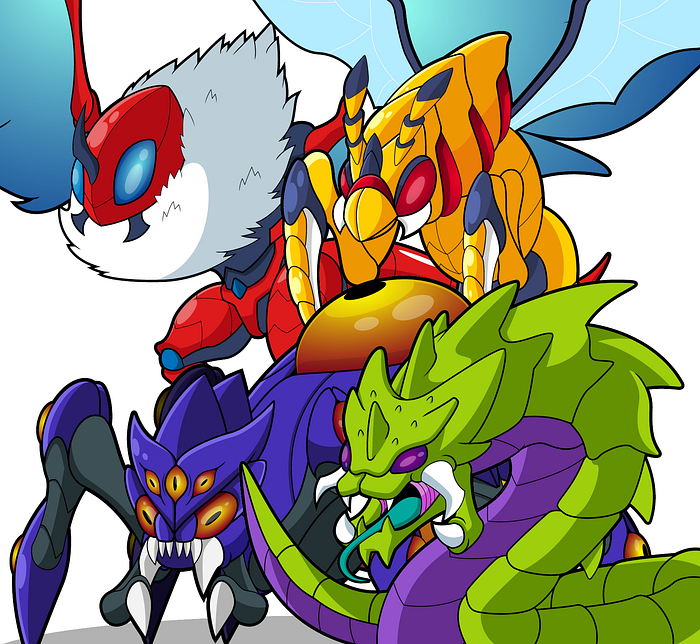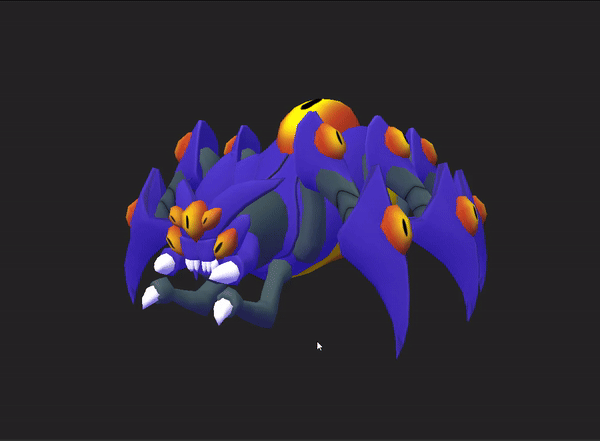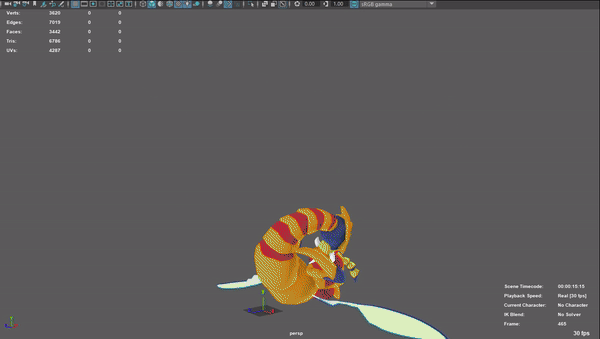Under The Hood — Volume 3
Work In Progress

Visit “Under The Hood” forum in our Community Discord
Week 9—Juroka Minions: Concept to 3D
In crafting our enemy roster, we began by defining the essence of each creature — Bat, Wasp, Spider, and Snake — and then transforming them with an alien aesthetic. Our goal was to create foes that felt both familiar and otherworldly, merging recognizable features with unsettling alien traits. We envisioned these creatures as insect-like alien threats, heavily influenced by titles like Starcraft, but adapted into a unique toon style that aligns with our game’s atmosphere.

After refining the core designs, our 3D artist moved into sculpting, focusing on each creature’s form to make it visually distinct and instantly recognizable. Using a single baked material for each model, we emphasized defining textures like armor plates and scales, achieving a balance between detail and performance.




Seam placement was essential during the modeling and texturing process to ensure that each creature maintained a cohesive appearance. Each model was sculpted with a single baked material, focusing on details like armor plates, scales, and other defining textures that could bring out their unique alien characteristics without layering complex textures. For example, the Snake’s segmented body and the Spider’s armored legs were designed to flow seamlessly, ensuring that these natural transitions would remain visually smooth and unobtrusive.







Rigging and skinning each model introduced specific challenges as we worked to bind the skeletal structure to the mesh in a way that allowed natural movement without causing visual distortions. Setting up bones and joints for each creature, especially those with complex forms like the Wasp and Spider, required meticulous attention to avoid issues of clipping and stretching. Adjusting bone weights and skinning parameters helped minimize these distortions, allowing the creatures to animate fluidly while preserving their unique shapes and details under various poses and movements.




Looking ahead, we’re excited to expand our lineup of alien threats with new creatures like scorpions, millipedes, flies, and worms. With each addition, we’ll continue refining our design techniques, pushing for even greater visual depth and cohesion within our alien ecosystem. The future is promising, and we’re eager to cultivate a diverse range of content that keeps players engaged and immersed in the evolving world of our game.
Week 10— Fishing: Location Concepts
In developing many of the Colony arcade games, our goal was to create vertical slices that encapsulate a character’s story. One such example is our fishing game, which offers players the relaxed opportunity to catch fish, trade them on the market, or cash them in for rewards.
A crucial element in crafting this experience was the level design. While the broader Colony game features diverse and procedural environments, we aimed to ensure that the fishing game remained a focused and immersive experience. To achieve this, we have envisioned three distinct location types for the fishing game: lakes, rivers, and canals.

- Lakes: Lakes are expansive bodies of water featuring a rich and diverse ecosystem. They provide areas where heavy water settles away from active currents, creating a layered fishing experience. On the surface, players can find fish that thrive in stagnant water, while the bottom layers are home to hardy, bottom-dwelling species that hide among weeds and debris. This “water below water” scenario draws inspiration from underwater ponds found in our oceans, offering a varied and immersive fishing environment.

- Rivers: Rivers present a dynamic system with fast-moving surface waters and slower currents beneath. This constant flow brings a fresh supply of resources to the ecosystem, supporting rapid swimmers and active bottom feeders. Players will need to stay agile to catch swift top-layer fish, while also navigating the more reserved species that prefer the quieter depths. The interplay between the different water layers creates a lively and challenging fishing experience.

- Canals: Canals offer a more sparse but uniquely engaging fishing environment. While they house fewer fish, the experience is distinct, often free from debris and trash. If players do encounter debris, they can catch and turn it in for rewards, potentially discovering valuable items. Designed primarily for transporting water and goods — a byproduct of colonization — the rapid currents in canals make using a spear the preferred method for reaching deeper areas.

These three level types — lakes, rivers, and canals — each provide unique environments and challenges for players, enriching the fishing game with diverse ecosystems and gameplay dynamics. As we continue to develop the game, we plan to expand and refine these areas by experimenting with different creatures and introducing new gameplay mechanics. This ongoing evolution will ensure that the fishing experience remains fresh, engaging, and ever-expanding for our players.
Listen to “Fishing Delight” — Game music here
Week 11— Alien Bosses Pt 1: Concept to 3D
For Jet Rider and future games, we envisioned a lineup of bosses that embody a broad spectrum of challenges — from introductory foes to towering adversaries and colossal behemoths. We wanted them to feel both alien and strangely familiar, striking a balance between the unknown and something recognizable. To find the right mix, we looked at popular themes in media, exploring everything from demonic and insectoid traits to monstrous designs. From this research, we crafted a selection of unique, captivating concepts, each with a distinctive purpose in gameplay.

The Jailer
Design: Inspired by iconic creatures in horror and fantasy, the Jailer draws from both demonic and insectoid influences, with a nod to Dark Souls’ menacing jailer archetype. Its spider-like form, with multiple sharp limbs and piercing, unblinking eyes, conveys an imposing presence designed to invoke both fear and awe. The creature’s bulky, armored exoskeleton suggests resilience, while its multiple eyes stare down the player with an ominous, watchful intensity. The design of the Jailer is purposefully unsettling, embodying the themes of confinement and oppression, making players feel trapped and hunted in its lair.

Gameplay Mechanics: The Jailer serves as a tutorial mini-boss, teaching players essential mechanics for future encounters. As the first significant threat, it encourages players to learn crucial skills like reading attack patterns, managing timing, and positioning themselves effectively in combat. The Jailer’s attacks are deliberate but powerful, giving players the opportunity to study and respond to its movements. It may launch stunning, web-like attacks or sweeping strikes that force players to dodge and retaliate in turn. The Jailer’s mechanics are designed to introduce players to a strategic approach in boss battles, ensuring they understand the fundamentals needed to tackle tougher opponents later on.





The Swarm
Design: The Swarm’s concept is grounded in the idea of overwhelming pressure, with a design reminiscent of both alien organisms and amorphous horror. Its blob-like form is composed of countless small, bat-like entities that pulse and shift as a single, sprawling mass. The vibrant colors and undulating shapes create a mesmerizing, chaotic effect that fills the screen, making players feel surrounded and encroached upon. The Swarm’s design emphasizes its nature as a relentless, ever-expanding threat that cannot be faced head-on without careful strategy.

Gameplay Mechanics: In gameplay, the Swarm introduces players to endurance-based mechanics, requiring them to remain calm under constant pressure. The creature is a massive bullet sponge with specific weak points, challenging players to aim precisely and hit these critical spots while evading an endless barrage of smaller, explosive creatures. The Swarm also deploys swarming bats that can obscure the screen, forcing players into a game of memory and quick reflexes as they track its weak points amidst the chaos. Timing becomes key here, as players must strike at the right moments to avoid being overwhelmed. The Swarm’s mechanics test players’ endurance, focus, and skill under pressure, pushing them to adapt to its relentless onslaught.







The Jailer and The Swarm set the stage with a blend of strategic learning and intense, chaotic encounters, challenging players to adapt and grow. But this is just the beginning — more alien adversaries await, each bringing unique tests of skill and endurance. Stay tuned as we dive deeper into the evolving threats that lie ahead…
Week 12 — Colony Survival: The KING (APC)
Survival on the Moon: Challenges and Game Mechanics
The moon’s desolate and unpredictable environment is a core gameplay element, and the survival mechanics are designed to amplify the sense of vulnerability when venturing far from the safety of your base. Supplies run thin, enemies lurk in the shadows, and resting at the wrong time could result in ambushes. This creates a compelling tension between exploration and risk management, forming a backbone for the gameplay loop. To address this, a “Survival Refit” mode has been introduced, offering players a chance to regroup, hide from threats, and strategize while in the wilderness. The interplay of these systems ensures players are constantly weighing their options: should they push further or prioritize safety?
The campfire system is an integral part of this mechanic. Players must decide when to light it for resting benefits while risking detection from nearby threats. The dynamic interplay between sound, light, and enemy behavior not only increases immersion but also ties directly into the game logic. For instance, suspicious noises in the wilderness prompt players to extinguish the fire, emphasizing stealth mechanics and tactical survival. This interplay introduces a layer of emergent gameplay, where player decisions directly influence world state and enemy AI behavior.

Resting and Buff Mechanics: Strategic Resource Management
The resting mechanic isn’t just a downtime activity but a strategic tool for preparation and recovery. It allows players to regroup their squad and apply various buffs or perks to enhance their chances of survival and efficiency. In its simplest form, resting offers universal buffs that apply uniformly to the team. However, as the player’s needs evolve, specialization becomes key. Roles such as combat specialists, miners, or medics can be enhanced through the resting system, creating a dynamic team synergy that aligns with the overarching gameplay strategy.

The technical design of the resting system involves player role identification and buff stacking logic, ensuring that bonuses don’t overlap redundantly and instead complement each other. For instance, a combat buff might increase weapon efficiency for one player while simultaneously improving the squad’s defensive capabilities. This modularity extends to the crafting of unique team compositions, encouraging experimentation. Importantly, in multiplayer, the absence of time skips ensures that every action, including resting, becomes an active gameplay decision rather than a passive timesink.
The KING of Survival: Modular APC Design
Enter the KING, a 40-foot (12.2m) modular campervan designed for survival under the harshest conditions. Its modular design not only defines its utility but also drives the core gameplay mechanics for exploration, defense, and adaptability. The KING represents the perfect blend of military-grade technology and player customization, with its components offering unique functionality and gameplay actions.


The modular framework revolves around a core hull that players can upgrade and configure using several slots:
- Windshield: Defines driver visibility and awareness, influencing optics-based interactions and enemy detection range.
- Cockpit: Functions as the vehicle’s command module, determining its movement style (e.g., aggressive tank-like handling or stealthy, nimble traversal). This also impacts how commands are issued to AI squadmates.
- Primary Module: Houses the key functionality of the vehicle, such as communications (boosting coordination and reconnaissance), radar (enhanced enemy detection), bunk beds (for resting buffs), storage (resource management), or ammo and medical supplies (supporting combat and survival).
- Utility Slots: Small auxiliary modules that cater to basic needs, such as weapon racks, first aid kits, or roll-up bed storage.
- Entrance Modules: Configurable as doors for access or turrets for defense/offense, adding versatility in combat scenarios.
- Storage Modules: Serve as universal storage unless turret modules occupy both entrances, at which point the storage is converted to smaller utility pods.
This modularity enables personalized vehicle builds that align with player strategies. For example, a combat-heavy squad may prioritize turret placements and ammo storage, while a mining-focused squad might favor radar modules and utility storage.

Interactivity: Action Economy and Minigames
Each module in the KING offers a single action or slot for a player to interact with during a phase. Once an action is performed, the module becomes temporarily locked, creating an action economy that adds depth to squad-based decision-making. This design merges elements of tabletop RPG logic with third-person shooter mechanics, introducing tactical choices at every turn. For instance, a player might prioritize loading medical supplies over defensive capabilities, knowing they can’t perform both actions within the same phase.
The lack of time skips in multiplayer creates an additional challenge during resting. Instead of passively waiting, players are presented with minigames to quantify the “value of sleep”. These minigames could involve maintaining ideal sleeping conditions, monitoring threats, or even managing internal disputes among the squad. The goal is to keep all players actively engaged, even during downtime, while also introducing mechanical variability to resting.


Emergent Gameplay: Experimenting with Modules and Isolation Mechanics
The KING’s modularity introduces exciting opportunities for emergent gameplay. Players can adapt their vehicles to the environment and threats they face. For instance, honking the horn at night might attract enemies to the vehicle, offering a chance to ambush or distract them. Similarly, converting the vehicle for amphibious travel by switching tires to pontoons opens up entirely new traversal opportunities. These systems interplay with environmental logic, creating a dynamic world where player actions have tangible consequences.
Isolation mechanics also play a significant role during nighttime gameplay. Inspired by the psychological tension of games like Don’t Starve, these mechanics introduce events that test player cohesion. Squads must band together to maintain morale and fend off threats, whether real or imagined. The fantasy elements enhance the survival experience, adding an otherworldly layer to the harsh lunar environment. For example, prolonged isolation could lead to hallucinations, impacting gameplay by introducing false threats or miscommunication between players.


Technical and Design Vision
The KING APC and its surrounding mechanics serve as the cornerstone of Colony Survival’s survival gameplay. The APC embodies the ABC’s of Survival: Adaptability, Balance, and Coordination. This concept highlights how the KING is not just a vehicle but a critical survival tool. Each module, system, and interaction reinforces these survival principles, ensuring players can tailor their strategies to overcome the challenges of the lunar environment.
The modularity of the KING allows for scalable complexity, making it accessible to new players while rewarding advanced strategies. The interplay between its modular design, resting mechanics, and environmental logic fosters a rich, emergent gameplay loop that constantly challenges players to adapt and innovate. As more modules and interactions are conceptualized, the KING APC will continue to refine how players experience survival, exploration, and squad dynamics in an ever-evolving lunar sandbox.


Visit the TOTHEMOON website
Follow TOTHEMOON Mission Control on Twitter @TTM_Universe
Hop on board the Space Stations & become a Cryptonaut: Discord/Telegram
